G.H. Cafe: A Dining Landmark On Battery Road
G.H. Cafe was a fashionable eatery in the business district that was popular among Singapore’s well-heeled. Vandana Aggarwal relives the history of this landmark institution.
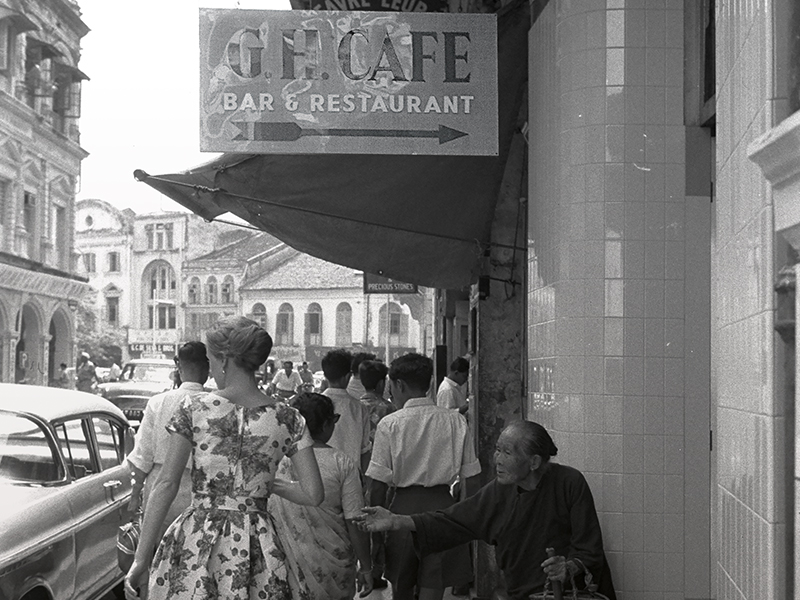 G.H. Cafe on Battery Road, 1962. In its heyday, this was where the affluent dined. Photo by Wong Ken Foo (K.F. Wong). Courtesy of National Archives of Singapore.
G.H. Cafe on Battery Road, 1962. In its heyday, this was where the affluent dined. Photo by Wong Ken Foo (K.F. Wong). Courtesy of National Archives of Singapore.
Hock Lai took him to the G.H. Cafe at nearby Battery Road. There were no hints anywhere what G.H. abbreviated stood for… The restaurant was air-conditioned, had plush upholstered chairs, white tablecloths, occasionally stained, and a fat Indian woman at the piano, singing old Broadway hits. Cole Porter, Oscar Hammerstein and Richard Rogers ghosted the large, comfortably darkened dining room, while young business executives and lawyers and doctors ate from plates with knife and fork and spoon. Silver cutlery a little worn from use. Cutlery, however, embossed with the letterings “G.H.”. Kwang Meng understood from Hock Lai that this same restaurant would be transformed into a bar, with girls and all, in the night. During the day, it only catered to the lunch throng.1
In 1972, Singaporean poet and novelist Goh Poh Seng published If We Dream Too Long, a book that has been described as the first true local novel. References to a G.H. Cafe on Battery Road appear periodically in the book, illustrating how a character in the story – because he now dines at the cafe – has risen up the social ranks.
A Sweet Treat
G.H. Cafe was not a figment of Goh’s imagination. It was a real cafe that was located on Battery Road. In its heyday, this was where the well-heeled had tea, businessmen hobnobbed and lawyers dined.
G.H. Cafe began life as G.H. Sweet Shop, located at 31 Kling Street (present-day Chulia Street), and started advertising its delectable offerings in The Straits Times in October 1920.2 There has been much speculation about what the initials “G” and “H” stood for. While some believe they were short for “Grand Hotel”, others have attributed it to businessman G.H. Kiat.3 However, in all likelihood, they were the initials of the eatery’s European founder, Mrs Gertrude Howe.4
According to a Straits Times report on 13 October 1920, the sweets on display at G.H. Sweet Shop were “sold under the chop ‘G.H.’ which conceals the identity of a lady who evidently has nothing to learn in the art of sweet making”.5 Advertisements promoted the shop’s “new delicious sweets made fresh daily in Singapore”. These could be purchased from various outlets around town, including hotels, or directly from the shop itself. G.H. Sweet Shop soon became the go-to place for wedding and Christmas cakes, ice lollies and sweets.6 Such was its reputation that someone even bought a G.H. Sweet Shop cake for the Sultan of Johor’s birthday in September 1922.7
By then, the shop had moved to larger premises at 6 Battery Road, and later to 7 Battery Road next door. The ground floor comprised a cake and tiffin room while the second floor had tea rooms and another tiffin room.8 Part of the shop space was rented out for exhibitions of art works. In 1924, G.H. Sweet Shop opened the Tea Kiosk overlooking the lake at the Botanic Gardens.9
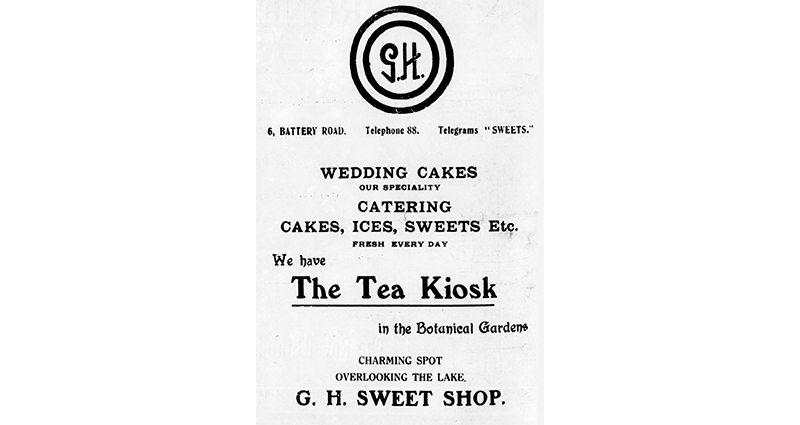 An advertisement of The Tea Kiosk, operated by G.H. Sweet Shop, at the Botanic Gardens. Malayan Saturday Post, 19 April 1924, p. 4. Retrieved from NewspaperSG.
An advertisement of The Tea Kiosk, operated by G.H. Sweet Shop, at the Botanic Gardens. Malayan Saturday Post, 19 April 1924, p. 4. Retrieved from NewspaperSG.
G.H. Sweet Shop also supplied confectionery to places such as Hong Kong and Rangoon (present-day Yangon) “carefully packed in tins”. In Singapore, the G.H. brand gained patronage of the well-heeled of society. The establishment catered food for events at the Yacht Club and guests at horse races, and also ice-cream for balls held at Government House (today’s Istana).10
Changes Afoot
Around 1926, G.H. Sweet Shop was put up for sale for unknown reasons. It was eventually purchased for $12,000 by Armenian businessmen John Eleazar Johannes and his brother Basil Eleazar Johannes, in partnership with fellow Armenian Arathoon Martin Sarkies, a cousin of the Sarkies brothers of Raffles Hotel fame. The men took out a loan from Chettiar moneylenders11 for the acquisition.12
Money was pumped in to redecorate and furnish the shop, enhance the kitchen and augment the food menu. The restaurant, which reopened around early 1927, operated till 10 pm nightly, serving a la carte meals.13 Its cakes remained the most sought-after item on the menu and patrons were advised to order Christmas cakes “in advance so as to avoid disappointment as was the case last year”.14
Within two years, however, poor management by the Johannes brothers resulted in their bankruptcy.15 In August 1931, The Singapore Free Press reported that G.H. Sweet Shop would be liquidated. Fortunately, prominent Parsi merchant Navroji R. Mistri16 stepped in to save the business and became its new proprietor that same month. Determined to give it a new lease of life, Mistri renamed the shop “G.H. Cafe” and sought to “improve the amenities and the scope of business”.17
Under Mistri, G.H. Cafe continued churning out cakes and confectionery while continuing its restaurant and catering business. In 1932, Raffles Institution held its annual dinner there and the following year, the cafe catered for almost a thousand guests at Mrs Ong Sam Leong’s18 71st birthday celebration held at New World Cabaret.19
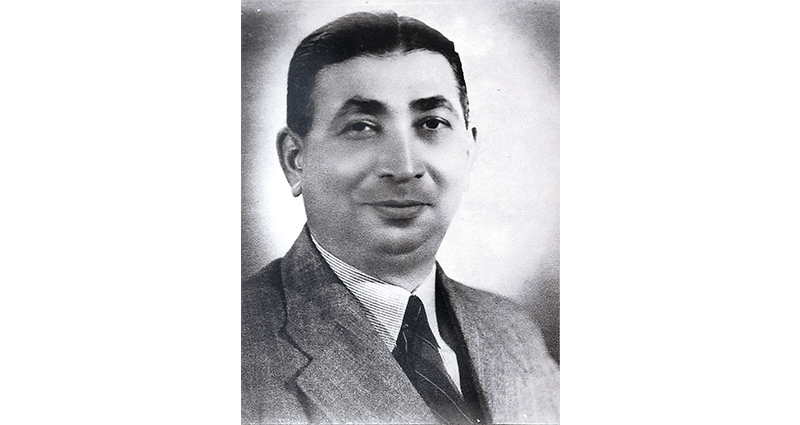 Navroji R. Mistri (1885–1953) was a businessman and philanthropist who acquired G.H. Cafe in August 1931. The Mistri Wing of the Singapore General Hospital and Mistri Road are named after him. Courtesy of Mr and Mrs Noshir Mistri.
Navroji R. Mistri (1885–1953) was a businessman and philanthropist who acquired G.H. Cafe in August 1931. The Mistri Wing of the Singapore General Hospital and Mistri Road are named after him. Courtesy of Mr and Mrs Noshir Mistri.
A Popular Hangout
With business doing well, Mistri decided that the restaurant needed a face lift. When G.H. Cafe reopened in 1935 after an extensive refurbishment, it featured a lounge with terrazzo flooring and comfortable low chairs upholstered in green. The main hall, tastefully painted in shades of grey and green, had 40 tables that could accommodate up to 200 diners and ceiling fans to cool the place. Tea and dinner dances could now be held on the spanking new dance floor, accompanied by music played on an automatic electric gramophone.20
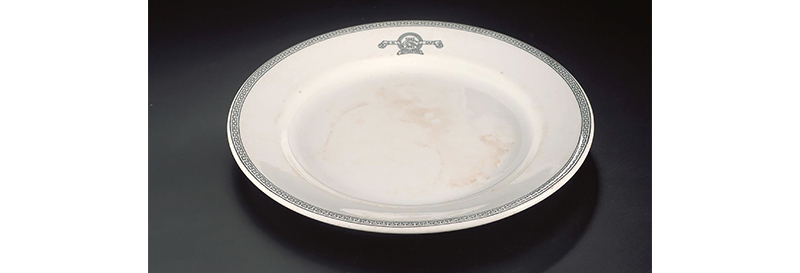 A porcelain plate bearing the logo of G.H. Cafe, 1980s. Courtesy of National Museum of Singapore, National Heritage Board.
A porcelain plate bearing the logo of G.H. Cafe, 1980s. Courtesy of National Museum of Singapore, National Heritage Board.
G.H. Cafe was a popular venue for hosting visiting dignitaries, wedding receptions and high-profile society events. In 1935, the women-only Lotus Club held a dinner at the cafe in celebration of its jubilee anniversary which saw, for the first time in the club’s history, male attendees.21 Other events held at the cafe included the annual general meetings of the Medical Practitioners of Singapore, the Old Boys of St John’s College of Jaffna in Ceylon (now Sri Lanka) and the Christian Brothers Old Boys Association.
G.H. Cafe continued to operate during the Japanese Occupation. Mrs Myna Ruth Segeram, who worked in the Library Section of the Economic Research Department for a Japanese officer, remembers that very often, she and other co-workers “piled into his car and went down to G.H. Cafe in Battery Road and he gave us a treat of ice-cream”.22 Mr Trevelyan Hale, a Eurasian who joined the Customs Department during this period, held his wedding reception at the cafe in 1944.23
After the war, G.H. Cafe became synonymous with an upmarket tea house and luncheon venue. Scotsman Hugh William Jamieson, who arrived in Singapore in 1946 and worked in the vicinity of Raffles Place, recalls the cafe as a “superior place” with “white tablecloths and proper cutlery”.24
Such was the popularity of the cafe that it continued to operate even after an external wall collapsed, taking down part of the first floor. This happened at about 8.30 am on 12 October 1948. Fortunately, there were no customers at the time, and the manager and the chief bartender narrowly escaped with their lives. Later in the day, customers nonchalantly carried on with their meal even as debris was being cleared.25
G.H. Cafe was also an ideal venue to impress a girl, according to a poem written by an “A.S. Lee” and published in The Straits Times in July 1949. He wrote:
“A picture in silk and lace by Elsie May,
If my darling, my winsome Jenny!
“I will bring her then to the G.H. Café
Where we chat and eat cakes and sip tea”26
A week later, a European resident in Singapore penned a witty poem in response to Lee, admonishing him thus:
“Dear A.S. Lee, you ought to see,
You’ll ne’er have little Jennys
If you eat cakes and sip your tea
At such expensive venues!…
“I don’t pretend you should not spend
Fair sums to please fair Jenny,
But there are less expensive shops
Than in the Jalan Batt’ry!”27
To expand its customer base, G.H. Cafe began putting up advertisements that emphasised the affordability – yet uncompromising quality – of its meals.28
The cafe had a large repertoire of dishes catering to different tastes. In 1935, Indian cuisine was served at a dinner hosted by Mrs J.T.N. Handy29 in aid of the St Andrew’s School building fund,30 while Rijsttafel tiffin was cooked for the delegates of a Rotary Club conference.31 G.H. Cafe also regularly catered at weddings. In 1953, the cafe hosted a dinner party on the occasion of the wedding of Devan Nair (who would be appointed President of Singapore in 1981). Guests included future prime minister Lee Kuan Yew and his wife, Kwa Geok Choo.32
G.H. Cafe was well patronised at breakfast, lunch and afternoon tea. The day would begin with morning shoppers who dined and relaxed in the cafe before the lunchtime crowd descended. According to prominent Indian businessman Rajabali Jumabhoy, “at 11 o’clock most shipping and insurance people used to go for coffee or a drink at G.H. Cafe and bargains for cargo and insurance… [were] often made there.”33 Tea-drinking crowds thronged the cafe in the late afternoons. However, the cafe was generally closed in the late afternoons unless an event was held there.
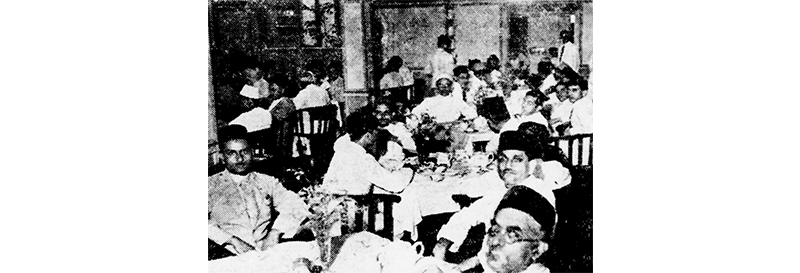 A farewell tea party hosted by the Indian Chamber of Commerce at G.H. Cafe for founding member Jamnadas Purshotam. The Singapore Free Press and Mercantile Advertiser, 16 April 1936, p. 2. Retrieved from NewspaperSG.
A farewell tea party hosted by the Indian Chamber of Commerce at G.H. Cafe for founding member Jamnadas Purshotam. The Singapore Free Press and Mercantile Advertiser, 16 April 1936, p. 2. Retrieved from NewspaperSG.
Post-Mistri Era
Following Mistri’s death in 1953, G.H. Cafe continued to operate under the same name. Peter Chua Hock Seng, a well-known racehorse owner, became a partner and the managing director of G.H. Cafe until his demise in 1960.34 The cafe remained a trendy place for hosting visitors, club meetings, office parties and all manner of celebrations. Nicolas Tang, who was then a salaried partner with law firm Allen & Gledhill, recalls that G.H. Cafe was a popular haunt for lawyers in the 1970s:
“When we went to the High Court on summons in chambers days, we would walk back to Raffles Place, and have coffee at the G.H. Cafe in Battery Road… together with its sinfully delicious kaya cake. If we missed coffee, we could always go there for lunch and sit at a table reserved for lawyers (a sort of ‘mess table’).”35
A Quick Decline
By the mid-1970s, however, the cafe’s accounts were in the red. The management attempted to reinvent the cafe as a nightclub and cocktail lounge in a bid to save the business. In 1973, G.H. Cafe became known as Singapore Kitchen & Cocktail Lounge. The next year saw the space being transformed into a nightclub called Singapore Mini Nite-Club.36 In 1975, the night club was renamed Golden Lucky Cocktail Lounge and, a few months later, Seven-Up Restaurant and Cocktail Lounge.37 Despite the series of makeovers and rebranding, the business failed to revive and went into liquidation in 1981.38 While G.H. Cafe no longer exists today, it remains a fond memory for an older generation of Singaporeans.
 Vandana Aggarwal is a teacher and a freelance journalist. An active citizen archivist for the National Archives of Singapore, she is the author of the book Voice of Indian Women: The Kamala Club Singapore (2018). She enjoys reading and researching about history.
Vandana Aggarwal is a teacher and a freelance journalist. An active citizen archivist for the National Archives of Singapore, she is the author of the book Voice of Indian Women: The Kamala Club Singapore (2018). She enjoys reading and researching about history.
NOTES
-
Goh, P.S. (2020). If we dream too long (p. 28). Singapore: NUS Press. (Call no.: RSING S823 GOH) ↩
-
Page 3 advertisements column 2. (1920, October 18). The Straits Times, p. 3. Retrieved from NewspaperSG. ↩
-
Chew, D. (Interviewer). (1984, November 30). Oral history interview with Hale, Trevelyan James Ruthven [Recording no. 000476/27/21]. Retrieved from National Archives of Singapore website. ↩
-
Lee, P. (interviewer). (1997, November 3). Oral history interview with Jamieson, Hugh William [Recording no. 001968/2/2]. Retrieved from National Archives of Singapore website. ↩
-
Untitled. (1920, October 13). The Straits Times, p. 8. Retrieved from NewspaperSG. ↩
-
The Straits Times, 18 Oct 1920, p. 3. ↩
-
Untitled. (1922, September 16). The Straits Times, p. 10. Retrieved from NewspaperSG. ↩
-
Page 7 advertisements column 2. (1922, April 1). The Straits Times, p. 7; Untitled. (1924, July 1). The Straits Times, p. 8. Retrieved from NewspaperSG. [Note: Tiffin is a colonial term for light tea-time meals.] ↩
-
Untitled. (1925, March 5). The Straits Times, p. 8; Page 4 advertisements column 2. (1924, April 19). Malayan Saturday Post, p. 4. Retrieved from NewspaperSG. ↩
-
The “G.H.” Shop. (1922, April 11). The Singapore Free Press and Mercantile Advertiser, p. 12. Retrieved from NewspaperSG. ↩
-
The Chettiars hailed from Chettinad in India’s Tamil Nadu state, a caste of Tamil moneylenders. They acted as full service bankers by providing liquidity in the form of working capital loans, syndicated loans, investment capital and demand drafts. For more information, see Ng, M. (2017, Oct–Dec). Micro India: The Chettiars of Market Street. BiblioAsia, 13 (3): 10–17. Retrieved from BiblioAsia website. ↩
-
Purchase of G.H. Sweet Shop. (1929, July 10). The Singapore Free Press and Mercantile Advertiser (Weekly), p. 9. Retrieved from NewspaperSG. ↩
-
Bankruptcy court: Former owners of G.H. Sweetshop. (1929, July 13). The Malaya Tribune, p. 7; Page 20 advertisements column 1. (1927, November 5). The Singapore Free Press and Mercantile Advertiser, p. 20. Retrieved from NewspaperSG. ↩
-
Untitled. (1927, November 22). The Singapore Free Press and Mercantile Advertiser, p. 9. Retrieved from NewspaperSG. ↩
-
Bankruptcy Court: Johannes’ deals in shares. (1929, July 13). The Singapore Free Press and Mercantile Advertiser, p. 11. Retrieved from NewspaperSG. ↩
-
Navroji R. Mistri (1885–1953) was a businessman and philanthropist, who donated $950,000 to the General Hospital for a new ward and $50,000 to the University of Malaya. The Mistri Wing of the Singapore General Hospital and Mistri Road are named after him. See National Library Board. (2017). Navroji R. Mistri written by Joshua Chia Yeong Jia. Retrieved from Singapore Infopedia website. ↩
-
Page 2 advertisements column 3. (1931, August 17). The Singapore Free Press and Mercantile Advertiser, p. 2; Page 16 advertisements column 4. (1931, August 22). The Malaya Tribune, p. 16. Retrieved from NewspaperSG. ↩
-
Mrs Ong Sam Leong was the widow of prominent Chinese businessman Ong Sam Leong (1857–1918). The biggest grave in Bukit Brown Cemetery belongs to the couple. Their sons Ong Boon Tat and Ong Peng Hock opened the New World amusement park in 1923. See National Library Board. (2016, July). Ong Sam Leong, written by Lee Hwee Hoon. Retrieved from Singapore Infopedia website. ↩
-
Birthday party: Mother Of Ong brothers honoured. (1933, December 22). The Malaya Tribune, p. 12. Retrieved from NewspaperSG. ↩
-
Around the town. (1935, February 15). The Singapore Free Press and Mercantile Advertiser, p. 4. Retrieved from NewspaperSG. ↩
-
Lotus Club jubilee dinner on Saturday. (1935, May 13). The Straits Times, p. 12. Retrieved from NewspaperSG. ↩
-
Tan, B. L. (Interviewer). (1985, July 3). Oral history interview with Segeram, Myna Ruth (Mrs) [Recording no. 000580/7/2, p. 31]. Retrieved from National Archives of Singapore website. ↩
-
Chew, D. (Interviewer). (1984, November 30). Oral history interview with Hale, Trevelyan James Ruthven [Recording no. 000476/27/22]. Retrieved from National Archives of Singapore website. ↩
-
Lee, P. (Interviewer). (1997, November 3). Oral history interview with Jamieson, Hugh William [Recording no. 001968/2/2]. Retrieved from National Archives of Singapore website. ↩
-
They were drinking coffee when the wall fell down. (1948, October 13). Morning Tribune, p. 1. Retrieved from NewspaperSG. ↩
-
Hand in hand in Singapore. (1949, July 23). The Straits Times, p. 9. Retrieved from NewspaperSG. ↩
-
How to get married and live happy ever after. (1949, July 30). The Straits Times, p. 9. Retrieved from NewspaperSG. ↩
-
Page 6 advertisements column 2. (1934, July 21). The Singapore Free Press and Mercantile Advertiser, p. 6; Page 2 advertisements column 2. (1936, April 9). The Malaya Tribune, p. 2; Retrieved from NewspaperSG. ↩
-
Mrs J.T.N. Handy was a founding member of the Indian and Ceylonese Ladies’ Club, which was the first club for Indian women in Singapore. ↩
-
Women’s interest: Indian dinner. (1935, July 19). The Singapore Free Press and Mercantile Advertiser, p. 4. Retrieved from NewspaperSG. ↩
-
The social spotlight: Rijstafel tiffin. (1935, June 16). The Straits Times, p. 8. Retrieved from NewspaperSG. [Note: A creation of the Dutch colonists, Rijsttafel is a meal comprising several Indonesian dishes served buffet style, with rice being the centrepiece of the menu.] ↩
-
Lee-Koh, A.M.C. (Interviewer) (1981, August 21) Oral History Interview with Nair, Chengara Veetil Devan. [Transcript of recording no. 000049/26/12, p. 113]. Retrieved from National Archives of Singapore website. ↩
-
Lim, H.S. (Interviewer). (1981, July 2). Oral history interview with Jumabhoy, Rajabali. [Transcript of recording no. 000074/37/5, p. 37]. Retrieved from National Archives of Singapore website. ↩
-
Partner in cafe, lorry driver die in spate of crashes on roads. (1960, December 26). The Singapore Free Press, p. 1. Retrieved from NewspaperSG. ↩
-
Tang, N. (2013, June 28). Singapore legal practice in the 70’s [Blogpost]. Retrieved from nicolastang.com website. ↩
-
Page 1 advertisements column 4. (1973, April 25). New Nation, p. 1; Page 10 advertisements column 2. (1974, October 17). New Nation, p. 10. Retrieved from NewspaperSG. ↩
-
Page 9 advertisements column 1. (1975, March 22). The Straits Times, p. 9; Reutens, L L. (1975, April 4). Bak koot teh in cool comfort. New Nation, p. 14. Retrieved from NewspaperSG. ↩
-
Page 17 advertisements column 3. (1981, November 19). New Nation, p. 17. Retrieved from NewspaperSG. ↩

